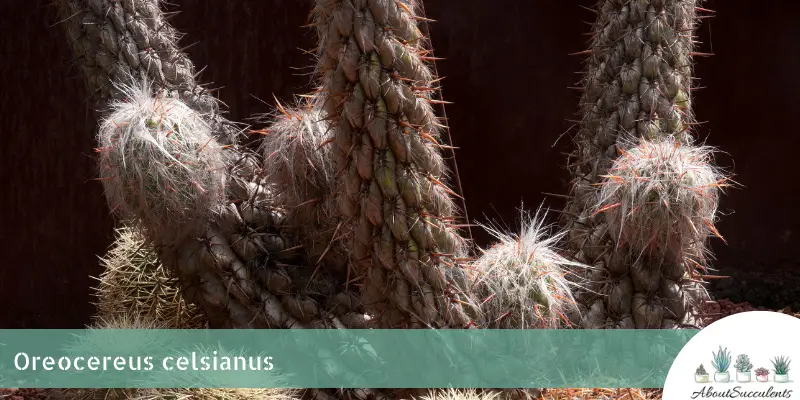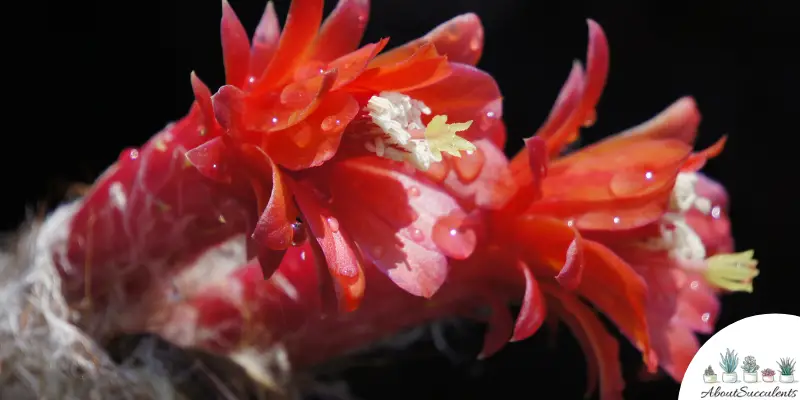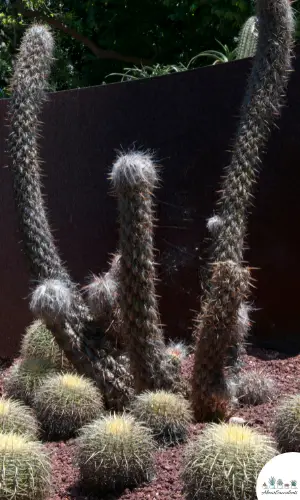
Oreocereus celsianus. also known as “Old Man of the Andes”, is a succulent plant that grows unbranched cylindrical stems that have silky white drooping hairs and long, orange-brown spines.
This gigantic cactus can grow up to 3m (10’) tall and 61cm (24”) wide. In spring, Oreocereus Celsianus blooms tubular semi-funnel-shaped flowers that grow up to 7cm – 9cm (2.75”-3.5”) long and 3cm (1.18”) wide.
The beautiful satiny flowers of the Old Man of the Andes come in different hues such as bright red, lilac-pink, orange, yellow, magenta, and white.
Oreocereus Celsianus is native to northwestern Argentina and dry highland regions of Andes, Bolivia. It’s part of the Oreocereus genus of the Cactaceae family.
General Information:
Also known as: Old man of the Andes
Plant Family: Cactaceae
Origin: Andes, Bolivia
Height: 3m (10’)
Exposure: Partial to Full Sun
Water Needs: Drought-resistant; use “soak and dry” watering method
Soil Type: Cactus mix combined with plenty of mineral grit such as pumice, perlite, and coarse sand
Soil pH: 5.0 to 6.5
How to Grow and Care for Oreocereus Celsianus

Oreocereus celsianus is a towering succulent plant that can be grown indoors while it is still young. It’s best to move the “Old Man” outdoors before it reaches full maturity. However, if your house is built with high ceilings this plant will make a beautiful corner piece.
Despite its intimidating height and appearance, this plant is easy to care for and grow. It’s frost-hardy and can tolerate temperatures as low as −12 °C (10 °F). Old Man of the Andes thrives well in temperatures of 10°C – 32°C(50°F – 90°F).
Sunlight
If you will grow Oreocereus Celsianus outdoors, place its container or make sure it’s planted in a location where it can be exposed to partial to full sun for 5 to 6 hours daily.
The thin hairs that cover the plant from top to bottom provide ample protection from heat. However, it cannot withstand direct exposure to intense sunlight. During a heatwave, move your succulent plant to a shaded area.
Indoors, you can place your young Oreocereus celsianus on a sunny window sill facing South. Old Man of the Andes will go into etiolation where its stems stretch out and wither if it doesn’t get enough sunlight.
When it outgrows the height of your window sill, move it outdoors where it will get the light exposure it needs.
Watering

The Old Man of Andes is the perfect house plant for busy people because it can survive for weeks without water.
Use the “soak and dry” method of watering. Water the soil thoroughly and wait for it to dry completely between waterings. Avoid overhead watering or misting. Water the soil and not the plant.
Test the soil’s dryness level by inserting your finger 2” deep into the soil. Keep in mind that the roots of succulent plants rot easily and overwatering will kill them.
In spring and summer, water your cactus once a week. In winter, give them little to no water because they enter their dormant phase.
Pot and Soil
Use a Terracotta or ceramic pot with drainage holes for your Oreocereus celsianus. This type of container prevents moisture retention.
Your house plant needs a well-draining potting mix. Use a cactus mix to ensure good aeration and water drainage. Combine it with plenty of mineral grit such as pumice, perlite, and coarse sand.
During spring and summer, add diluted cactus fertilizer to your soil once a month. This will provide additional nutrients your plant needs when it is actively growing.
The old man of the Andes is a fast-grower. It will outgrow its pot every spring. You need to repot it several times before it reaches its maximum height of 10 feet.
How to Propagate Oreocereus Celsianus
Oreocereus celsianus can be propagated from stem cuttings and seeds. The best time to take cuttings or sow seeds is in summer or spring.
Method 1: Stem Cuttings
Step 1: Choose stems that are not dry or damaged.
Step 2: Cut the stems across with a disinfected knife or shears.
Step 3: Leave the cuttings to dry in a warm area in a vertical position. Dry small cuttings for 5-7 days and large cuttings for 10-14 days.
Step 4: When the base of the stem cutting has been callused, place it in a container filled with sand, peat, and some charcoal. Allow your cuttings to grow roots in the temporary substrate.
Step 5: When the roots appear, repot your Oreocereus celsianus in terracotta or ceramic container filled with cactus mix combined with grit.
Method 2: Propagating from Seeds
Step 1: Get a container without holes.
Step 2: Fill the bottom of your container with charcoal and gravel up to 1” high. Top it with fine gravel and coarse sand. Next, add the compost made up of equal portions of cactus compost, coarse sand, and ground charcoal. Top it with small gravel or rocks.
Step 3: Divide the top layer into equal parts and insert your seeds with a tweezer. Spray little water on the seeds. Cover the tray with plastic and put it on top of a heating pad.
Step 4: Place your container in an area exposed to indirect light. Use artificial lighting if necessary.
Step 4: When seedlings appear, repot them in a terracotta or ceramic container with drainage holes. Use cactus mix combined with gritty materials such as perlite, pumice, or sand.
Frequently Asked Questions
Is Oreocereus Celsianus Toxic to Pets?
Oreocereus Celsianus is not listed as toxic to cats and dogs on the website of the American Society for the Prevention of Cruelty to Animals (ASPCA).
However, it is best to keep your pets away from them because their spines and needles can be harmful.
Why is My Oreocereus Celsianus Dying?
These are the two culprits for your cactus’ declining health: Overwatering and pest infestation.
Overwatering
Excessive watering of drought-resistant succulents will lead to root rot which can progress to fungal infection. If you are guilty of water overdose, act quickly to save your Old Man of the Andes from dying.
Cut out all the damaged parts with a disinfected knife or shears. Next, use gloves or tongs to gently remove Oreocereus Celsianus from the container. Brush off excess soil from the roots.
Start cutting all the rotted roots. Place your cactus in a dry and warm area while you prepare your fresh pot.
Fill a terracotta or ceramic pot with fresh cactus mix with pumice, coarse sand, and perlite. Plant your cactus and wait for a week before you water the soil. Dry out the soil before watering again.
Pest Infestation
Armored scale and mealybugs are the most common pests that attack Oreocereus Celsianus.
You can remove scales with tweezers or a high-pressure water spray. Make sure that the water pressure is not too strong so as not to damage your plant. Treat your cactus with a systemic insecticide to prevent recurring scale infestation.
To remove mealybugs, spray your plant with 70% rubbing alcohol or diluted neem oil.
Does Oreocereus Celsianus Produce Flowers?
Yes, Oreocereus Celsianus blooms breathtaking semi-funnel-shaped flowers in spring.
Last Updated on June 9, 2022 by Sofia Lara